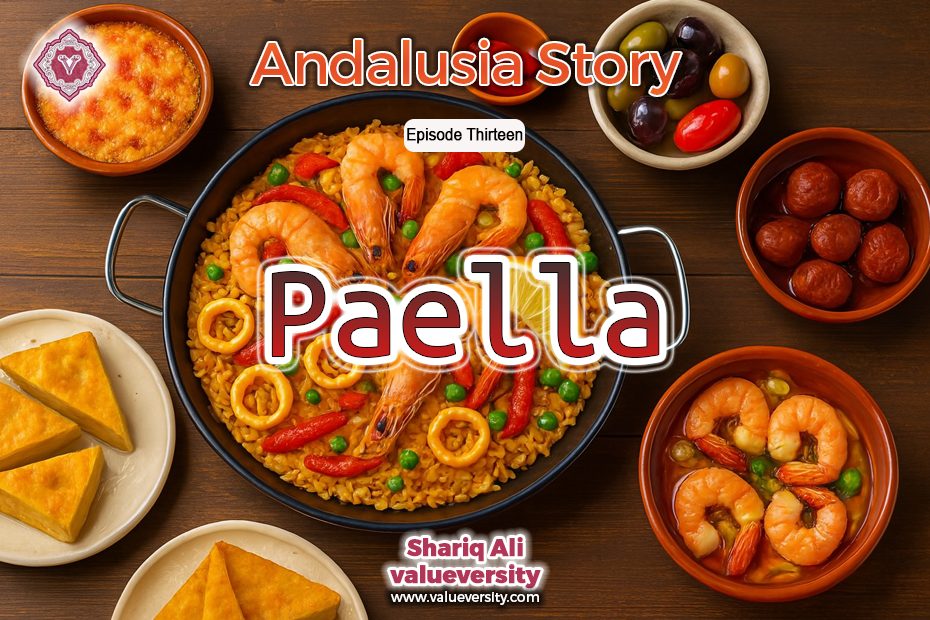Paella – Spain’s Biryani,Andalusian Story, Episode Thirteen
Shariq Ali
Valueversity
The restaurant was upscale, but instead of sitting inside among the artificial decorations, we chose the open sidewalk, where a small round table for two waited in the soft golden sunlight. A light chill in the air made the atmosphere pleasant. Sunlight filtered through the green leaves of a nearby tree—sometimes touching our faces, sometimes falling on the flowers arranged in the vase on our table. We had already visited the Alcázar Palace, and this was our lunch break before the guided tour of Seville Cathedral.
The restaurant was not too crowded. A smiling waiter attended to us with quiet courtesy.
When our order was ready, he first opened a foldable table and placed it beside us. Then he carried out a large black hot pan filled with our chosen dish—Spain’s famous paella. Steam rose from it, carrying the aroma of saffron, olive oil, and fresh seafood, filling the air with fragrance.
With neat precision, the waiter served the paella onto our plates. Golden rice mixed with glistening vegetables, succulent prawns, and tender pieces of calamari looked like strokes of color on a painter’s canvas.
Paella’s cultural roots lie in Valencia, where farmers, after a long day in the fields, would combine whatever they had—rice, vegetables, sometimes rabbit or chicken—and cook it in a large pan. Over time, this rustic meal reached royal courts and eventually became a symbol of Spain itself.
Saffron is the essential soul of paella, lending it its golden color and unique aroma. The rice grains are soft yet separate, the spices delicately balanced. At times one tastes the smoothness of olive oil, at others the tang of a lemon drizzle, or the fresh flavor of prawns from the sea.
Spain is also world-famous for its tapas—small portions of food enjoyed in evening gatherings with friends. Sometimes it is olives, sometimes nuts, sometimes little pieces of meat. Together, they reflect the essence of Spanish cultural life.
After lunch, we joined our group for the guided tour of Seville Cathedral. Showing our tickets at the entrance, we passed through a long corridor that opened into a vast courtyard. The trees around its edges looked centuries old, reminiscent of the courtyards of ancient mosques where worshippers once stood in prayer.
On one side stood a tall square tower. The guide explained that this was La Giralda, originally built as the mosque’s minaret for the muezzin. Later, it was incorporated into the cathedral. Interestingly, the tower has no stairs—only sloping ramps. Tradition holds that horse-drawn carts once ascended them, carrying the muezzin—or later, church attendants—to the top with ease. Even today, when you see the tower, that story seems alive.
We then entered the cathedral itself with the group. The vast hall, with its towering walls and arches adorned with intricate carvings, immediately captured our attention.
The guide told us that apart from the Vatican in Rome, this is the largest Gothic church in the world. Its construction began in 1401, after the old mosque was demolished. Yet some parts built by Muslims, such as the spacious courtyard and the minaret, remain preserved.
The central hall was breathtaking: lofty ceilings, stained-glass windows filtering light, and lavish ornamentation everywhere. Along the sides were smaller chapels, built by wealthy landlords and nobles at their own expense, each wishing to secure a private burial place and prayer chamber.
The most striking part was the main altar, whose decoration alone took nearly a century to complete. The golden statues and delicately carved wooden panels reflected the immense labor and wealth poured into it.
Then the guide shared an intriguing but controversial detail: the tomb of Christopher Columbus is also housed here. For centuries, disputes raged over where his remains were actually buried. Even DNA tests were carried out in the twentieth century to prove that at least some part of his remains indeed lies in Seville. Today, the tomb is a major tourist attraction. But for us, it was not particularly moving—we simply exchanged a smile and moved on.
When the tour ended, we strolled back through the bustling markets to our hotel. After a short rest, we prepared for the evening, when we were to witness the famous Flamenco dance.
…to be continued
